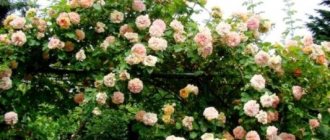Don't know how to care for roses in the garden in summer to prolong their flowering throughout the season? Believe me, there is nothing complicated about this. Processing roses in summer comes down to a few simple but necessary tasks that should not be forgotten.
Watering, pruning, fertilizing, mulching and cuttings - how to avoid getting overwhelmed in the summer bustle and missing something important. In case caring for roses in the summer is not your thing, we have compiled a detailed cheat sheet, after studying which you will definitely become, if not a guru, then a completely passable rose grower.
Rule 1: Trimming
The main pruning of the bush is carried out in the spring, after the winter shelter is removed from it. In summer, they do not rejuvenating, but formative pruning. In this case, withered and damaged stems are removed, and summer fungal diseases are also prevented. Here the branches are shortened. They can be pruned thoroughly, as young shoots quickly grow in size. In addition, branches with fruit ovaries should be removed from the bush. They draw the juices that nourish the flower onto themselves.
Pruning roses
Advice: at the time of pruning, only young branches should not be touched. It is on them that new rose buds are subsequently tied.
It is important to remember that summer pruning gives the rose bush a special decorative appearance. That is, the shrub more actively awakens dormant buds from such treatment. As a result, new shoots and buds are formed. This means that if you care for roses in the garden in the summer in this way, then the bushes will bloom profusely.
Advice from experienced gardeners
Before planting a rose cutting in indoor or outdoor ground, it is recommended to prepare the soil. It should be light and fluffy, with neutral or low acidity.
Attention! You cannot place a rose garden in areas that are located near swamps or groundwater: in such places the flower often gets sick. This is especially true for gardens in the Leningrad region, the Urals, Siberia and the middle zone.
It is not recommended to feed the rose more than once every 2 weeks. An excess of microelements is just as dangerous as a deficiency. Experienced gardeners advise recording when and how much fertilizer was applied. This will help avoid mistakes in care.
To understand the condition of the rose, it is regularly inspected. For example, the presence of black spots indicates that the plant lacks potassium and magnesium, and the falling of petals indicates an excess of water. In this case, the soil is loosened and sprinkled with sand.
Rule 2: thorough weeding + mulching
All weeds should be removed regularly between rose bushes. If you ignore this rule, the grass will clog the root system of the bush. And the garden plot with roses itself looks untidy in this form.
After weeding, the root zone of the rose is covered with mulch. In this case, you can use mowed grass. It’s just important to make sure it doesn’t have seeds. Otherwise, the weed will sprout with renewed vigor. If you care for roses in this way in the summer, then the bush will bloom wildly.
Reproduction of climbing roses by layering
You can propagate a rose by layering, and it is very easy to do. To do this, you need to select the healthiest and strongest shoots. A ditch is dug near the bush and the soil at the bottom is loosened. Pour a layer of humus on top and lay the selected shoot vertically. Next, the ditch is filled with earth and watered abundantly. Already in the spring, this shoot, having taken root, will become an independent plant. To improve rooting and survival rate, you need to prevent it from blooming this summer by tearing off the emerging buds.
Rule 3: watering
Rose needs abundant and regular moisture. Therefore, you need to water the bushes as the soil dries out. To do this, use water slightly warmed in the sun. When watering, it is important to avoid getting water on the leaves or flowers.
The total volume of water per bush is calculated according to its age. Because the root system of the rose goes deeper into the ground every year. The older the rose, the more water it needs.
Watering
For heavy loamy soils, you can water roses less frequently. Because moisture stays in them longer. Light sandy loam soils require more frequent watering of the rose. During the rainy season, there is no need to moisten the flower.
Advice: the main thing is to monitor the soil of the bush and not allow it to dry out completely.
Features of summer rose care
Lush blooming of roses is the result of timely and competent care. The flower needs regular watering and fertilizing, loosening and weeding. Gardeners prune annually to prevent the development of diseases and pests.
They also pay attention to protective measures - they treat the bushes with fungicides and complex fertilizers. To achieve better results, summer residents combine procedures. For example, weeding is carried out along with loosening, and immediately after pruning the flower is treated to protect it from diseases.
Rule 4: nutritional supplements
A flowering rose bush is in dire need of potassium-phosphorus feeding. To do this, you can buy ready-made preparations or use natural ingredients. If you take ready-made mixtures, then they are diluted with water according to the instructions. The bushes are watered with the solution according to the indicated scheme. Banana peels or chicken manure can be used as natural potassium fertilizers. They are laid around the root zone of the rose in a not too thick layer. Feed the rose with potassium-phosphorus mixtures until the end of August with an interval of 2-3 weeks.
Advice: stop feeding the bushes with nitrogen around July.
Interesting: Planting roses in summer
Fertilizer for roses in summer
To set buds and prolong the flowering period, roses need phosphorus and potassium. Magnesium, which affects color, iron, as protection against chlorosis, manganese and boron also have a positive effect on the appearance of prickly beauties. But nitrogen should only be added to the soil in the spring, because it delays the flowering process, promotes foliage growth and weakens the bushes in the face of disease.
Fertilizers can be applied in liquid or dry form. Whatever method you choose, first pour plenty of soil around the bush and fertilize not the center of the rose, but the soil at a distance of 10-15 cm from the stems.
Throughout the summer (once a month), roses can be fed with a solution of 10 g of superphosphate and potassium sulfate per 10 liters of water. In July, 500 g of chicken manure and 10 g of nitrophoska, as well as 2 cups of ash, are added to the solution.
Feeding roses after flowering is important for the next season. To prevent the bush from weakening from bearing lush inflorescences, in the fall add a mixture of 16 g of potassium monophosphate and 15 g of superphosphate dissolved in 10 liters of water under it. It is worth watering the bushes at the rate of 2 liters of fertilizer per adult bush and 1 liter per bush in the first year of life.
You can also foliar feed roses during flowering. For this, use specialized preparations, for example, Buton Plus, diluting 1 sachet of the product in 2 liters of water.
Rule 5: spraying
Therapeutic spraying of a flower in the country or in the garden is carried out if signs of fungal diseases or pests are found on the bush. If there is powdery coating, brown or yellowish spots on the leaves, you need to treat the plants with an antifungal compound. You must act according to the instructions. Spraying is carried out in the evening in the complete absence of wind.
If you really don’t want to use store-bought preparations, then you can use decoctions of garlic, horseradish, horsetail, hot pepper, nettle or wormwood for spraying. These same solutions are not only therapeutic, but also prophylactic. That is, it prevents the appearance of sores on the rose.
Mulching roses in summer
Ideally, it is advisable to mulch roses immediately after planting, and in the fall, renew the mulch layer to get rid of weeds, pests and fungal spores that have gotten into it. However, if for some reason you did not do this in the spring, mulch the roses during flowering.
Mulch for roses can be very diverse and even increase the decorativeness of the flower bed. In addition, under a layer of 7-10 cm, the soil will not cake, moisture will be retained longer, and nutrients from the gradually rotting mulch will be evenly supplied to the roots.
If you don’t know what to mulch roses with, try straw, peat, humus, and pine cones. In extreme cases, cardboard and unpainted paper will do, but such a flowerbed will not look very presentable.
Rule 6: Pest Control
As a rule, the queen of flowers is more often affected by aphids. If you notice whitish larvae on the leaves, you can carefully wash them off with water, remove them with your hands, or use a soap solution to treat the plant. They spray the bush from all sides. If the aphids are not removed, the buds may not bloom.
Caterpillars, larvae and aphids can also be removed using a decoction of hot pepper. It is prepared from 1 liter of water and five to six peppercorns. The solution is infused for a day, then filtered and the bush is sprayed against pests.
Another good insect repellent is a three percent solution of hydrogen peroxide. They are used to treat roses in dry and windless weather. Spraying is carried out once a week as needed. This mixture can be used all summer.
Wood ash is used as another natural fungicide and pesticide. It is also a potassium fertilizer. You can powder the plant with wood ash after each spraying.
Insect pests
Tip: you can also use sulfur and copper fungicides. They cope with scab, spider mites, powdery mildew and other ailments. Sulfur is especially successful in this.
Interesting: How to rid your garden of ticks
Favorable conditions for roses to bloom in the garden
The rose does not grow well in the shade, so it is planted in a sunny area. With a lack of sun and light, diseases occur and the plant withers. It is recommended to choose a place with low groundwater levels, otherwise high humidity will provoke the development of fungi.
The soil must be fertile, with a drainage layer. The recommended acidity level is low or medium.
Another important condition for favorable flowering is the absence of northern winds and drafts. Rose is a southern flower that does not tolerate sudden changes in weather. When planting, there should be free space between plants for air microcirculation.
Growing roses too close together will lead to the development of diseases and insect pests.
Protection from diseases and pests
Roses suffer from pest attacks quite often, so their cultivation is unthinkable without regular preventive treatment. The most common rose pests include:
- aphid;
- litsovertka;
- spider mite;
- rose sawfly;
- bronze;
- weevil.
Anemones - growing and care in open ground
An important role in the fight against these pests is played by the spring treatment of plants with insecticides. This procedure is carried out after removing the cover and pruning, most often at the end of March. For spraying, use a 1% solution of copper sulfate or a special ready-made preparation intended specifically for treating roses.
After the plants begin to grow and before budding begins, if necessary, this treatment can be repeated.
Attention! It is not recommended to treat plants during flowering, but in case of severe damage, it is still worth spraying the bushes. Perhaps the drug will harm the flowers, but the bush itself can be saved.
Shelter for the winter
This point is worth considering in a little more detail. The safety of plants depends on the quality of the shelter, but it is equally important to remove it in time and carry out a number of measures that are relevant at this time.
Peonies planting and care in open ground at the dacha
Roses are heat-loving plants. They are prepared in advance for overwintering, namely:
- create conditions for shoots to ripen;
- stop fertilizing with nitrogen in the second half of summer;
- reduce the frequency of watering.
In this way, the plants gradually move into a calmer phase and prepare for winter. In October, before covering, unripe shoots and flowers should be cut off, then before frost sets in, the bushes should be hilled to a height of 10-12 cm.
With the onset of stable frosts, climbing roses are removed from their supports and laid on the ground, and standard roses are bent to the ground and pinned. Leaves, spruce branches, and peat can be used as shelter. For additional insulation, a structure is constructed from non-woven material.
Attention! A layer of dry grass or leaves should be placed on the ground under the lashes to prevent contact with wet ground. This will prevent the shoots from rotting when the snow melts in the spring.
Roses should be provided with shelter for the winter.
In early spring, as soon as the snow melts, the plants are freed from shelter. You should not open the roses completely right away - a sudden opening can harm them. As it warms up, it is necessary to gradually remove the insulation, layer by layer. After the plantings are completely cleared, pruning is carried out, during which all damaged and diseased shoots are removed.
How to prune faded rose buds to bloom again
Those who try to prune the flower itself, without the branch, only make things worse for their rose bushes. The remaining branches stretch upward, becoming thin and weak. Why should a shrub waste its energy on growing branches if it can form lush buds? Faded roses should be cut along with the branch to the first leaf, the first bud, or using the long cut method - up to the 3rd bud from the bottom. Which cutting method to choose depends on several factors.
How to properly make a cut on a branch
If the flower is located on a shoot from the root, then long pruning should be used. On such a shoot you should leave 3 buds at the bottom. This season the shoot will no longer bloom, but will branch out next season. But after such pruning, the bush can produce another flowering shoot from the root.
For your information! For young roses that bloom for the first time, the branches are cut in half. Two-year-old bushes are cut to the second or third bud at the base of the shoot.
The middle cut is used most often. It is suitable for bushes more than two years old, as well as for multi-flowered varieties that bloom in whole bouquets. Medium pruning is done to the shoot or bud. The shoot should be strong, it will bear the following buds. If the cut is made to the bud, it should be oriented outward.
A short cut is used closer to August, so as not to wait a long time for the growth of new branches. It is needed to remove only flowers. A short cutting method will not provoke the release of new buds in the fall. This is what is required to prepare a rose for winter. But if you use the method at the beginning of summer, after the first flowering, the result will not be satisfactory. Many buds will appear, but they will be small, thickened and weak. The flowers do not last long on the branch.
Important! Like any pruning of roses, summer pruning is also done on a dry, sunny day. The cut on the rose itself is made at an angle of 45°
Just 1 cm higher above the bud or shoot. Thus, the decorative nature of the branch is preserved, and the cut is made invisible. If you cut higher, then often such a branch simply dries out. The cut site heals quickly and does not require additional treatment
The cut itself on the rose is made at an angle of 45°. Just 1 cm higher above the bud or shoot. Thus, the decorative nature of the branch is preserved, and the cut is made invisible. If you cut higher, then often such a branch simply dries out. The cut site heals quickly and does not require additional treatment.
To prepare the fertilizer you need to take yeast and ash
Shivers as a fertilizer for roses are used in combination with ash fertilizer; they contain a lot of vitamins, trace elements, minerals, and growth substances. All this stimulates plant growth and strengthens their resistance to various diseases. Root formation under the influence of yeast solution is also accelerated.
In addition, yeast activates the activity of soil microorganisms. At the same time, the composition of the soil improves significantly; nitrogen and phosphorus are formed from organic matter. True, yeast absorbs potassium, but to neutralize this effect, additional fertilizing with ash is used. It is applied directly to the ground in the form of an ash solution.
The main condition for the effectiveness of yeast feeding is warmth. In the cold, microorganisms are not able to continue their development and produce useful compounds; they either stop growing or die altogether.
Prevention and treatment of diseases
The most common disease of roses is powdery mildew. It occurs if the bushes are planted too densely, they are not weeded or thinned out, and they are in a shady place. The leaves of a diseased plant become covered with a grayish coating and turn black. If you do not spray with a fungicide, the bush will die by autumn. Use Bordeaux mixture. For prevention in rainy summers, you can use Fitosporin.
When pests appear, use Fitoverm, 30 Plus, Tiovit Jet.
How to plant
To make flower beds pleasing to the eye and bring less trouble, it is important to adhere to planting deadlines and properly prepare and disinfect the soil, follow the planting scheme and select high-quality planting material
Deadlines
The best time to plant seedlings is spring
It is important to wait until the soil has warmed up and the threat of frost has passed. The optimal soil temperature is not lower than +12 C
It is also not worth delaying planting roses in open ground; in unfavorable weather conditions, it is better to cover young plants with covering material than to be late with replanting.
On a note! For better development of the root system of future plants, it is important that the soil is not too dry and that the sun has not yet entered its active stage of action. In autumn, roses can also be planted in open ground; it is important that the flower has time to create a root system before the onset of frost; there should be at least one month left before the first snow
In autumn, roses can also be planted in open ground; it is important that the flower has time to create a root system before the onset of frost; there should be at least one month left before the first snow
How to prepare the soil
Stagnant moisture at the roots of the fragrant beauty is detrimental to the plant, so drainage is placed at the bottom of the planting holes. Expanded clay, charcoal, river pebbles or crushed stone can serve as drainage. Roses love “greasy” soil; the planting hole must be fertilized with rotted manure or humus mixed with sand or base soil.
Before placing the seedling in the hole, pour boiling water or a solution of potassium permanganate over it, it is advisable to add a few handfuls of wood ash. These measures disinfect the soil, fight fungi and insect pests living in the soil.
Preparation of planting material
It is recommended to purchase seedlings from reliable sellers: nurseries or specialized stores. Parameters of healthy seedlings:
- The root system is well developed, the roots are without signs of rotting or damage.
- There are 3-4 green branches on the trunk - leaves.
- The green color is bright, dark green, without yellow spots, holes or white bloom.
- The roots are well moistened.
- The height of young shoots reaches 10-15 centimeters.
- Seedlings with a closed root system take root better.
Before planting, the bushes are additionally moistened and sprayed with a solution of potassium permanganate or brilliant green. The roots must be straightened directly into the planting hole.
How to plant correctly
Roses do not grow well in dense plantings; the flowers do not have enough sunlight and air. It is better to plant plants in a checkerboard pattern at a distance of 60-80 centimeters. The depth of the planting hole is 1 meter, it is necessary to install drainage, the diameter of the hole is 50-60 centimeters.
The bush is planted in the center of the planting hole, carefully straightening the roots, the plant is watered and covered with a mixture of base soil and humus, then the soil is compacted.
Important! You cannot fill the grafting site with soil; it should be 3 centimeters above the ground level. Tree trunk circles can be mulched with a layer of sand; direct contact of the stem with organic fertilizers should not be allowed
The tree trunk circles can be mulched with a layer of sand; direct contact of the stem with organic fertilizers should not be allowed.
Garden types of roses
Based on the history of selection, garden roses are divided into ancient and modern, bred after 1867.
Vintage roses
This group consists of roses that have lost their rose hip appearance due to complex hybridization. The shape of the flowers is flattened or close to a ball, the number of petals is large. The color is light, pastel, the most common range of shades is pink. The bushes are formed tall, with a large number of buds. Flowering per season is usually once. The exceptions are remontant and bourbon.
The disadvantages of these roses include poor resistance to low temperatures and rain, buds and petals fall off. They are also often affected by fungal infections.
| Type/variety | Height (cm) | Color | Peculiarities |
Alba roses:
| 200. | White, cream. | Undemanding to soil, resistant to frost and infections. |
Portland:
| 100-120. | Violet. | Pleasant aroma. Repeated bud formation. |
Bourbon:
| 150. | Orange. The whole range of pink shades. | Autumn bloom. They are susceptible to fungal diseases and require shelter for the winter. |
Centifolic (centifolal):
| 90-140. | From white to coral. | Low growing, spreading. Rarely found in landscaping. |
Damascus:
| 100-200. | Snow-white. Light purple. | The inflorescences are very fragrant. The greenery of the bush is sparse and sparse. |
Gallic:
| 90-180. | Cherry, red. | Long shoots. Large leaves. |
English
This group is often highlighted separately due to its versatility of use. If necessary, the English rose can be used in the garden to make either a compact or spreading bush, a standard tree or a hedge. These plants are resistant to adverse conditions and are easy to care for. They tolerate shaded areas well, with enough sunlight for 4-5 hours.
The flower is cup-shaped, like those of ancient roses, collected from many folded petals. In some varieties the number reaches two hundred. Many bushes are repeat bloomers. They have beautiful and bright aromas of myrrh, musk and citrus.
The most popular are 3 varieties:
- Abraham Derby;
- Benjamin Britten;
- William Shakespeare.
Modern roses
All modern garden roses are divided into groups, which should be considered in more detail.
Hybrid tea
Distinctive features: large flowers 10-14 cm, graceful in the shape of glasses. There are both double petals with 25-35 petals and densely double petals with 50-60 pieces. Peduncles are long. The formation of buds occurs in June-July, after which there is a short two-week break, and the second wave of formation continues until the fall. The color range is represented by a variety of colors. Aromas range from light to rich.
The height of medium-sized bushes is 60-70 cm, and tall ones 80-100 cm. The difference in care is mandatory shelter in the fall.
Common varieties of hybrid tea roses:
- Mr Lincoln;
- Lucky Piece;
- Double Delight;
- Alexander.
Floribunda
This species is a hybrid obtained by crossing large-flowered roses. The buds are small in size and collected in large inflorescences appear during the summer until autumn. Often used for bouquets.
According to the height of the bush, there are giants 80-100 cm, grown as hedges, and short ones no more than 40-55 cm, divided into a separate subgroup - patio roses (miniflora), which are usually used to decorate the yard.
Suitable for forming borders and look impressive when planted in large groups. They tolerate rainy weather well and are resistant to many diseases.
The most fragrant representatives:
- Shocking Blue;
- Fragrand Delight;
- Melody Maker.
Grandiflora
Large-flowered, appeared during the crossing of hybrid tea and floribunda roses. Due to the formation of long shoots, they are used for cutting. They can bloom continuously for several months, which is why they are actively used to decorate gardens.
The most prominent representatives are: The Queen Elizabeth Rose and Sonja.
However, in many European countries this group is not officially recognized and its varieties are classified as floribunda roses.
Miniature
These dwarf roses are very similar to polyanthus. They are compact, miniature, often spherical bushes, 30 cm high. The buds are single or collected in inflorescences. The color varies, often in rich shades. Resistant to frost and various types of infections. Flowering continues all summer.
Used to decorate balconies, grow in pots and containers. In the garden they look good in the foreground of flower beds, as borders and paired with dwarf flowers.
Shrubs
Another name is semi-climbing. Large and spreading bushes 200-250 cm high. The shoots are characterized by rapid growth and require tying to supports. The flowers are large, densely double or sometimes simple, similar to rose hips. The aroma contains tea, musk and fruity notes.
The group of scrubs includes Canadian and Austin roses. Resistant to bad weather and all kinds of infections. They withstand winter well and are easy to care for.
Polyanthaceae
This group originated in France. The inflorescences are located at the ends of the shoots and consist of a large number of small buds from 20 to 60 pieces. Medium-sized bush 40-60 cm, compact, easy to care for.
Polyantha roses have a sufficient number of advantages:
- absence of thorns;
- high viability, easily restored from the root;
- tolerates cold and pest attacks well;
- flowers remain fresh and tidy for a long time, 10-14 days;
- can grow from seeds;
- perfectly tolerates excess moisture;
- feels good in a shaded area.
Climbing Ramblers
Most varieties of the group are hybrids of the rose Vishuriana. Feature: long shoots 200-1500 cm. The flowers are small, 2-3.5 cm, however, collected in large, densely arranged inflorescences. Suitable for decorating fences, creating hedges, and masking imperfections.
They have a two-year stem development cycle. In the first year, long, null stems grow from the soil; in the second, side shoots with buds appear in their middle and upper parts. In subsequent seasons, young shoots grow from the ground and on the lower parts of last year's branches.
Teahouses
The name was given because of the inherent aroma of these roses. The flowers have beautiful outlines and delicate shades of petals, the total number of which reaches 60 pieces. The buds are large, round or long-sharp, the shape depends on the variety. There are both low-growing bushes 50 cm and climbing ones 200 cm high.
The main disadvantage of this species is its poor resistance to frost.
Examples of varieties:
- Parade;
- Gloirede Dijon.
Ground cover
These creeping plants with small flowers and long stems owe their origin to the Rugosa rose and the Vihua rose hip. Because of this crossing, several varieties of ground cover flowers have appeared:
- Small 45 cm and medium from 50 cm.
- Large 100 cm and tall over 110 cm with drooping shoots.
Frost-resistant, some require light shelter, and many overwinter under a layer of snow. They are unpretentious in care and take root well.
Park
Park roses are tall shrubs 150 cm, with dense foliage. Many varieties are frost-resistant and are perfect for regions with cold climates. Blooms earlier in early June.
How to trim step by step
Rose Flammentanz - planting and care, how to prune after flowering
Choose a dry sunny day. Remove all dried, intertwined and sprouted shoots. On old bushes, lateral shoots with 3-4 well-developed buds are left; in healthy plants, they wake up simultaneously along the entire length of the branches.
The cut is made at a distance of 0.5-0.7 cm from the bud, at an angle of 45 degrees, so that excess moisture can easily roll off. The greenish and white color of the cut indicates that the plant survived the winter well.
Young, annual bushes try not to be pruned at all; only dead branches are removed. After the procedure, it would be a good idea to cover the cut areas with garden varnish and spray the bush with antifungal drugs.
Scheme for pruning roses of different types
Pruning old roses that have been growing in one place for many years (climbing, climbing, hybrid polyantha, floribunda) will rejuvenate the bushes, give them compact shapes, and help the plant receive more sunlight. In addition, it promotes good ventilation, which means it will minimize the likelihood of infection with fungal diseases.
Note! Polyanthus compact roses are not recommended for heavy pruning; only light adjustments are used.











